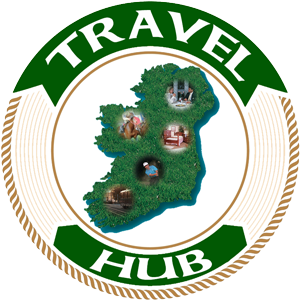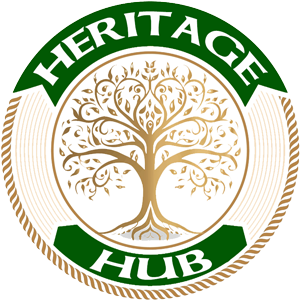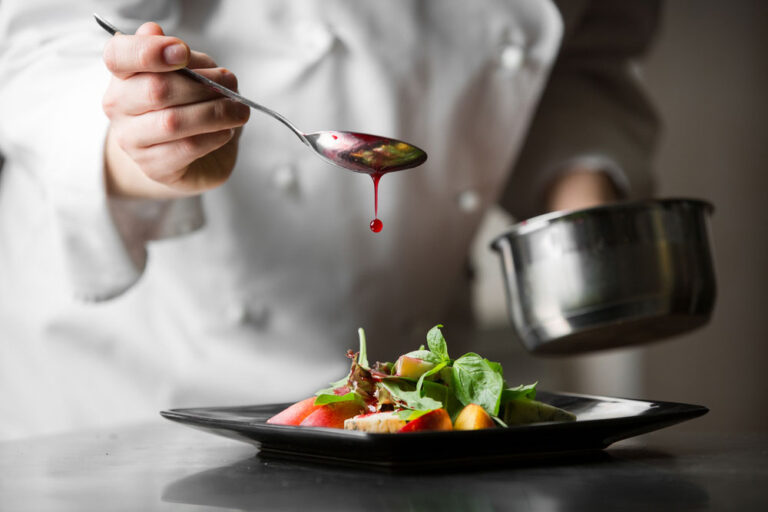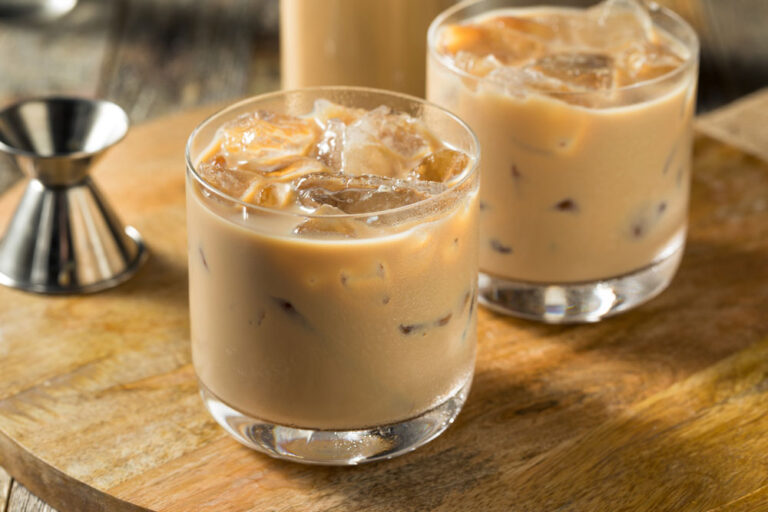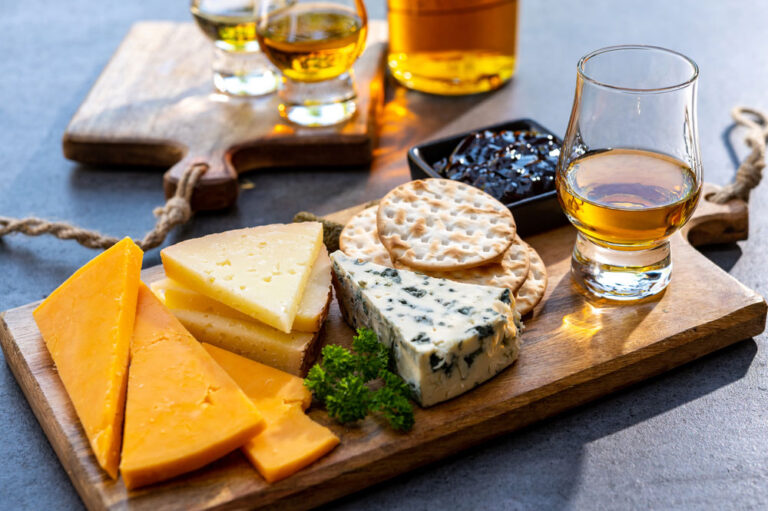When it comes to Halloween, Ireland holds a special place in its heart. This ancient Celtic festival, known as Samhain, is the precursor to today’s Halloween. Samhain marked the end of the harvest season and the beginning of the dark half of the year, which was often associated with death and the otherworld.
While Halloween has evolved into a worldwide festival of costumes, sweets, and all things frightening, its origins in Ireland are strongly rooted in custom and history. Halloween isn’t just a day here; it’s a season. The veil between the worlds of the living and the worlds of the dead is at its thinnest at this time.
The lighting of bonfires is one of the most enduring Irish Halloween traditions. Communities congregate around these blazing pyres to tell stories, sing songs, and dance. But what is a gathering if not for food? Samhain is a feasting holiday, and Irish cuisine shines during this eerie season. Traditional foods are consumed, each with its own symbolic meaning and story.
These foods bring people together, bringing warmth and nutrition in the middle of autumn’s frost, from the mystery origins of barmbrack to the soothing presence of colcannon and the whimsical allure of toffee apples.
So pull up a chair, light a candle, and come along with us as we explore Ireland’s Halloween culinary customs. We’ll look at the history, recipes, and tales behind these popular dishes, and discover how they’ve become a beloved part of Halloween in Ireland.
Barmbrack – Unwrapping the Fortunes of Halloween
As Halloween approaches, the aroma of freshly baked barmbrack permeates kitchens around Ireland. This traditional Halloween fruitcake is as mysterious as it is delicious and has been eaten for generations.
Barmbrack, also known as Bairn Breac in Irish (meaning “speckled loaf”), is a divination instrument as well as a sweet dessert. It’s claimed to forecast the destiny of those who find it because it’s baked with a variety of symbolic elements buried inside.
Traditionally, a ring, a coin, a piece of cloth, a pea, and a stick were placed in the barmbrack. Finding the ring meant you’d soon be wed, the coin foretold wealth, the cloth indicated poverty, the pea meant you wouldn’t marry that year, and the stick symbolized an unhappy marriage or disputes. While these items are less common today, the ring still holds strong as a symbol of impending marriage.
But before the fortunes are unveiled, the barmbrack itself is a delight. Made with dried fruit like raisins and sultanas soaked in tea, it’s often spiced with cinnamon and nutmeg. The dough is sweet, soft, and speckled with these fruity gems. It’s the perfect accompaniment to a cup of tea on a crisp October day.
Barmbrack reflects the spirit of Halloween in Ireland – a blend of ancient and new, delicious and mysterious. Stay with us as we explore more foods and their stories as we explore the flavors of an Irish Halloween.
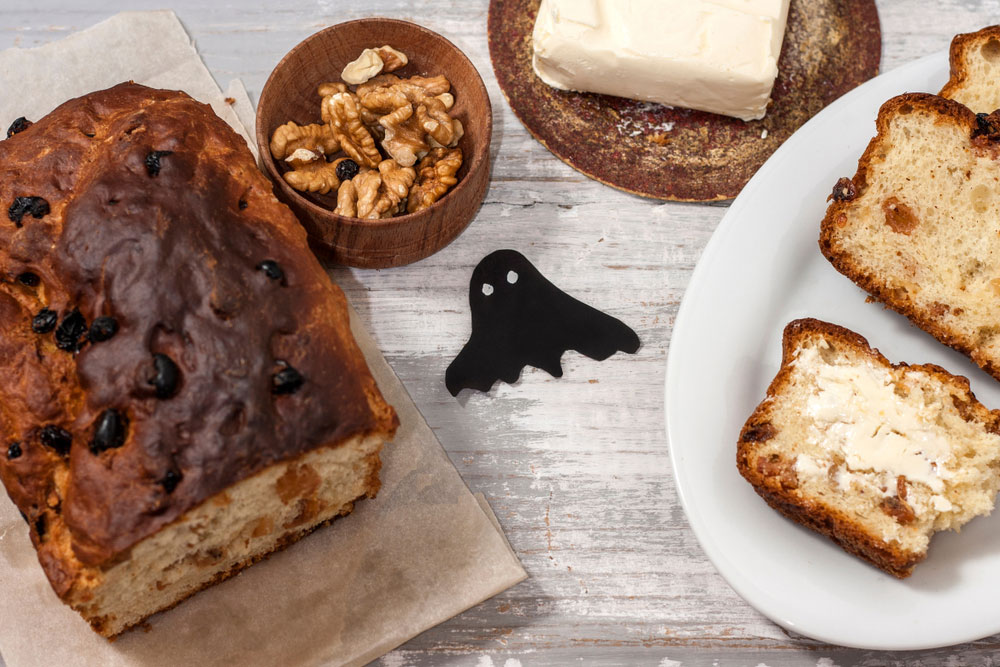
Colcannon and Champ – Comforting Classics for Halloween
Halloween in Ireland is a time when ancient and new traditions blend perfectly. Comfort food takes center stage when the days grow shorter and colder. Colcannon and champ are two dishes that encapsulate the essence of this season.
Colcannon: Mashed Potatoes with a Halloween Twist
Colcannon is a traditional Irish dish comprised of creamy mashed potatoes, finely chopped kale or cabbage, onions, and plenty of butter. It gets its name from the Gaelic “cal ceannann,” which means “white-headed cabbage,” a reference to one of the main ingredients.
This meal has a spooky Halloween connotation. Charms such as a ring, a coin, a thimble, or a button were said to be hidden within the colcannon. The ring represented marriage, the coin represented money, the thimble represented spinsterhood, and the button represented bachelorhood.
Despite its Halloween origins, colcannon is a popular Irish comfort dish all year. The mix of buttery mashed potatoes and somewhat bitter greens is a successful combination. It’s frequently served with a substantial stew or as a side dish to roasted meats. A plate of hot colcannon may warm both the body and the soul.
Champ: A Simpler, Scallion-Infused Delight
Champ is related to colcannon, but there are a few important differences. It’s cooked with mashed potatoes, but instead of kale or cabbage, it’s loaded with scallions (green onions). The term “champ” may derive from the Irish word “campóg,” which means “mashed or beaten.”
Champ has a simpler flavor profile than colcannon but is just as wonderful. The creaminess of the mashed potatoes, the freshness of the scallions, and a generous quantity of butter combine to form a delectable, no-fuss side dish.
While not commonly connected with Halloween charms, champ is a popular ingredient in Irish cuisine. It’s easy to make and goes great with a variety of meat and fish meals. It gives a flavor of Ireland’s culinary heritage to your table, just like colcannon.
As the leaves begin to fall and the days become colder, nothing beats a big helping of colcannon or champ to provide warmth and fuel. These dishes are a tasty reminder that Halloween customs in Ireland aren’t just about sweets, but also about savory treats that have been enjoyed for generations.
Try our colcannon recipe
Try our champ recipe
Apples, Nuts, and Spooky Stories: Halloween’s Traditional Touches
Apples and nuts may not be the first things that come to mind when you think of Halloween goodies. However, these traditional aspects have long been associated with Halloween in Ireland.
A Fun Tradition of Apple Bobbing
Bobbing for apples is a famous Halloween activity that has been played for generations in Ireland. Filling a huge basin or tub with water and placing apples in it is the game. The goal is to capture an apple using only your teeth and your hands behind your back. It’s a fun and occasionally difficult game that’s ideal for Halloween celebrations.
The game of bobbing for apples is thought to have ancient origins and is associated with the Celtic celebration of Samhain. Apples were thought to represent immortality and divination. The first person to bob for an apple successfully would be the next to marry.
Hazelnuts: Divination and Magic
Hazelnuts hold a place of significance in Irish Halloween traditions. They were used for divination and even considered magical in some beliefs. One common practice was to roast hazelnuts in the Halloween fire. These nuts would be named after the young people present and placed around the hearth. The nut that popped and jumped the most represented the person who would encounter the most challenges in the coming year.
Tales of the Banshee and the Dullahan
Ireland’s Halloween would be incomplete without some spine-chilling tales. The Irish countryside is rich in tradition, and Halloween is the ideal time to tell ghost stories.
The Banshee, a female spirit who is claimed to wail or keen, foretelling the death of a family member, is one of the most well-known Irish Halloween traditions. Hearing the Banshee’s wail is seen as a bad omen, and many Irish families have their own Banshee legends.
The Dullahan, a headless horseman who carries his head under his arm, is another terrifying creature in Irish Halloween legends. It is stated that if he does not ride, someone will die. These tales, both terrifying and interesting, remind us that Halloween in Ireland has a strong connection to the supernatural.
Halloween Eve: Snap-Apple Night
Snap-Apple Night was a popular term for Halloween night in Ireland, where family gathered to play games, eat traditional dishes, and tell stories. It was a night filled with laughter and a hint of the magical.
While many modern Halloween traditions in Ireland are similar to those in the United States, the incorporation of these time-honored practices gives the celebration a distinct and completely Irish flavor.
Ireland’s Modern Halloween – Combining the Ancient with the Modern
As Halloween approaches, the spirits of old Ireland awaken. The customs and traditions rooted in ancient Celtic beliefs continue to shape the way the holiday is celebrated across the country.
Trick or Treating with a Difference
Trick or treating has become a universal Halloween tradition, and Ireland is no exception. Children dress up in costumes, go door-to-door, and utter the famous phrase: “Trick or treat?” While they often receive sweets and candies, it’s not uncommon for some mischief to be involved, harkening back to the tradition of playing tricks on others during the Samhain festival.
Samhain’s Spirits and Bonfires
Bonfires are another enduring Halloween tradition in Ireland. People gather around these fires, often built on hilltops, to celebrate and ward off evil spirits. The bonfire’s blazing light is believed to have protective qualities, pushing back any malevolent entities that might be wandering during Samhain.
Turnips, pumpkins, and the Jack-O’-Lantern
The traditional Jack-O’-Lantern, which has become synonymous with Halloween, originated in Ireland. In Ireland, however, the traditional lantern was carved from turnips rather than pumpkins. The term “Jack-O’-Lantern” actually stems from the Irish folklore of “Stingy Jack.” The story is about a cunning yet deceptive man who played tricks on the Devil, only to find himself unable to enter either paradise or hell after death.
Children hollowed out turnips, carved hideous faces onto them, and set candles inside in the Irish version of this practice. Turnip lamps were then placed outside to ward off wandering ghosts. This custom developed when Irish immigrants in America embraced the pumpkin as a larger, easier-to-carve substitute.
Fancy Dress and Costumes
Costumes are now an expected aspect of Halloween in Ireland, especially for children. Popular Halloween costumes frequently include classic Halloween figures such as witches, ghosts, vampires, and ghouls. In recent years, there has been a trend toward more imaginative and diverse costume options, in keeping with Halloween’s worldwide nature.
Haunted Houses and Pumpkin Patches
In the run-up to Halloween, pumpkin patches and haunted homes have become popular attractions around Ireland. Families go to pumpkin farms to pick out pumpkins for carving, while haunted houses provide thrilling and terrifying experiences for those wishing to add a bit more horror to their night.
The Continuation of Tradition
Halloween in Ireland is a blend of old and new, a fusion of ancient customs and modern festivities. While the Halloween season often conjures images of a commercialized holiday with spooky decorations and candy, the heart of Irish Halloween is tied to the ancient Samhain festival.
As the sun sets on October 31st and darkness descends, the veil between the worlds thins, and the spirits of Ireland’s past come alive. It’s a time for storytelling, for acknowledging the supernatural, and for celebrating the rich cultural heritage that is at the heart of Halloween in Ireland.
